The Application of the Foam Technology to the Dust Control for Reducing the Dust Injury of Coal Mines
Abstract
:1. Introduction
1.1. Mine Dust Hazard
1.2. Dustproof Technology
- (1)
- Coal seam water injection
- (2)
- Spray dust reduction
- (3)
- Dust collector for dust removal
- (4)
- Ventilation and dust removal
- (5)
- Chemical dust suppression
2. Foam Dust Reduction Technology
2.1. Research Status
- Every ton of coal mined consumes 2–3 m3 of foam;
- The foaming liquid is 15–20 L;
- The dust removal efficiency in gently inclined coal seams is more than 94%;
- The dust removal efficiency in steeply inclined coal seams is 80% to 90%;
- It costs 8 to 12 kopecks per ton of coal mined.
2.2. Features
- (1)
- When the foam is sprayed on the rock or stockpile, the foam without voids covers the dust source, which fundamentally prevents the dust from spreading to the outside world;
- (2)
- When the foam liquid is sprayed into the dust-laden air, a large number of foam particles are formed, and their total volume and total surface area increase, which increases the collision efficiency with dust particles;
- (3)
- The liquid film of the foam contains a special foaming agent, which can greatly reduce the surface tension of water, rapidly change the wetting performance of dust, and increase the speed at which dust is wetted;
- (4)
- The foam has good viscosity, and once the dust contacts the foam, it will be quickly adhered by the foam, thereby increasing the adhesion efficiency of the foam and the dust.
2.3. Insufficient
3. Application
3.1. Application of Foam Dust Reduction in Zhangcun Coal Mine
3.2. Application of Foam Dust Reduction in Shanjiaoshu Coal Mine
- (1)
- 21,129 mining ventilation roadways
- (2)
- 21,108 transportation roadways
3.3. Application of Foam Dust Reduction in Jinjia Coal Mine
- (1)
- 11,181 fully mechanized mining working faces
- (2)
- 11,225 excavating ventilation roadways
4. Conclusions
Author Contributions
Funding
Institutional Review Board Statement
Informed Consent Statement
Data Availability Statement
Acknowledgments
Conflicts of Interest
References
- Shahan, M.; Seaman, C.; Beck, T.; Colinet, J.; Mischler, S. Characterization of airborne float coal dust emitted during continuous mining, longwall mining and belt transport. Min. Eng. 2017, 69, 61–66. [Google Scholar] [CrossRef] [PubMed] [Green Version]
- Sapko, M.J.; Cashdollar, K.L.; Green, G.M. Coal dust particle size survey of US mines. J. Loss Prev. Process Ind. 2007, 20, 616–620. [Google Scholar] [CrossRef]
- Chinese Center for Disease Control and Prevention/National Institute of Occupational Health and Poison Control. Available online: http://www.niohp.net.cn/jbjcbg/ (accessed on 18 June 2022).
- National Health and Family Planning Commission of the People’s Republic of China. Available online: http://www.nhfpc.gov.cn/ (accessed on 18 June 2022).
- China Coal Mine Safety Network. Available online: https://www.mkaq.org/html/2014/09/30/274021.shtml (accessed on 18 June 2022).
- Zavialova, O.; Kostenko, V.; Liashok, N.; Grygorian, M.; Kostenko, T.; Pokaliuk, V. Theoretical basis for the formation of damaging factors during the coal aerosol explosion. Min. Miner. Depos. 2021, 15, 130–138. [Google Scholar] [CrossRef]
- Korshunov, G.; Nikulin, A.; Kovshov, S. Review of dust deposition and dust explosion proofness in mine workings. Fire Prot. Saf. Secur. 2017, 252, 93–100. [Google Scholar]
- Shahani, N.M.; Sajid, M.J.; Zheng, X.; Jiskani, I.M.; Brohi, M.A.; Ali, M.; Ullah, B.; Qureshi, A. Fault tree analysis and prevention strategies for gas explosion in underground coal mines of Pakistan. Min. Miner. Depos. 2019, 13, 121–128. [Google Scholar] [CrossRef] [Green Version]
- Coal Mine Safety Supervision Bureau Personnel Department of the State (China). The National Coal Mine Extra Serious Accident Cases; China Coal Industry Publishing House: Beijing, China, 2009. [Google Scholar]
- Pang, C. The Safety Comprehensive Assessment System Study on the Coal Dust Control; Chongqing University: Chongqing, China, 2008. [Google Scholar]
- State Administration of Work Safety/State Administration of Coal Mine Safety. Available online: http://www.chinasafety.gov.cn/newpage/ (accessed on 19 June 2022).
- Kobylianskyi, B.; Mykhalchenko, H. Improvement of safety management system at the mining enterprises of Ukraine. Min. Miner. Deposits 2020, 14, 34–42. [Google Scholar] [CrossRef]
- Zhuang, Z.X. Discussion on high-efficiency dust control technology in xiaobaodang mine. Coal Technol. 2022, 41, 149–152. [Google Scholar]
- Liu, J.J.; Wu, C.F.; Chen, Z.Y. Experimental study on formulation optimization and performance of foam dust suppressant for transport road surface of open pit mine. J. Saf. Sci. Technol. 2022, 18, 163–169. [Google Scholar]
- Wang, Y.H.; Gao, M.; Zhao, S.B. Establishment and application of mine dust concentration prediction model. China Min. Mag. 2021, 30, 178–181. [Google Scholar]
- Zhang, K.X. Study Of Wetting Characteristics of Coal Body Active Agent Based on Surface Roughness; Henan University of Technology: Zhengzhou, China, 2020. [Google Scholar]
- Arya, S.; Sottile, J.; Rider, J.P.; Colinet, J.F.; Novak, T.; Wedding, C. Design and experimental evaluation of a flooded-bed dust scrubber integrated into a longwall shearer. Powder Technol. 2018, 339, 487–496. [Google Scholar] [CrossRef]
- Yang, M. Research On Discrete Foam Suppressing Coal Dust Technology; Southwest University of Science and Technology: Mianyang, China, 2021. [Google Scholar]
- Wang, Q.G.; Wang, D.M. Research on generation mechanism of mine dust. Saf. Coal Mines 2014, 45, 12–14. [Google Scholar]
- Shahan, M.R.; Reed, W.R. The design of a laboratory apparatus to simulate the dust generated by longwall shield advances. Int. J. Coal Sci. Technol. 2019, 6, 577–585. [Google Scholar] [CrossRef] [PubMed] [Green Version]
- Yang, H.S. Study on Spoiler Cavitation Addition Device of Foam Dust Suppression; China University of Mining and Technology: Beijing, China, 2020. [Google Scholar]
- Wang, J.W. Study on the Suppression of Dust Dispersion by Foam Sol; Tianjin University of Technology: Tianjin, China, 2022. [Google Scholar]
- Liu, X.X.; Zhu, H.Q.; Wang, D.M. New technology and practice of dust pollution control with foam jet in underground mines. J. Environ. Sci. Health Part A-Toxic/Hazard. Subst. Environ. Eng. 2019, 54, 39–47. [Google Scholar] [CrossRef]
- Zhu, X.; Wang, H.; Wang, D.; Xu, C.; Zhou, W.; Zhu, Y. Improved foam application at the tunnel face with large ventilation volume and low pressure supplied water. Tunn. Undergr. Space Technol. 2020, 95, 103139. [Google Scholar] [CrossRef]
- Lu, X.; Zhu, H.; Wang, D. Investigation on the new design of foaming device used for dust suppression in underground coal mines. Powder Technol. 2017, 315, 270–275. [Google Scholar] [CrossRef]
- Lu, X.-X.; Wang, D.-M.; Zhu, C.-B.; Shen, W.; Zhong, X.-X.; Xu, C.-H. A new adding method of foaming agent used for foam dust suppression in underground coal mines. J. Central South Univ. 2015, 22, 3116–3122. [Google Scholar] [CrossRef]
- Wang, H.; Chen, X.; Xie, Y.; Wei, X.; Liu, W.V. Experimental study on improving performance of dust-suppression foam by magnetization. Colloids Surfaces A: Physicochem. Eng. Asp. 2019, 577, 370–377. [Google Scholar] [CrossRef]
- Wang, H.; Wang, D.; Lu, X.; Gao, Q.; Ren, W.; Zhang, Y. Experimental investigations on the performance of a new design of foaming agent adding device used for dust control in underground coal mines. J. Loss Prev. Process Ind. 2012, 25, 1075–1084. [Google Scholar] [CrossRef]
- Lu, X.; Wang, D.; Xu, C.; Zhu, C.; Shen, W. Experimental investigation and field application of foam used for suppressing roadheader cutting hard rock in underground tunneling. Tunn. Undergr. Space Technol. 2015, 49, 1–8. [Google Scholar] [CrossRef]
- Xi, Z.; Jiang, M.; Yang, J.; Tu, X. Experimental study on advantages of foam–sol in coal dust control. Process Saf. Environ. Prot. 2015, 92, 637–644. [Google Scholar] [CrossRef]
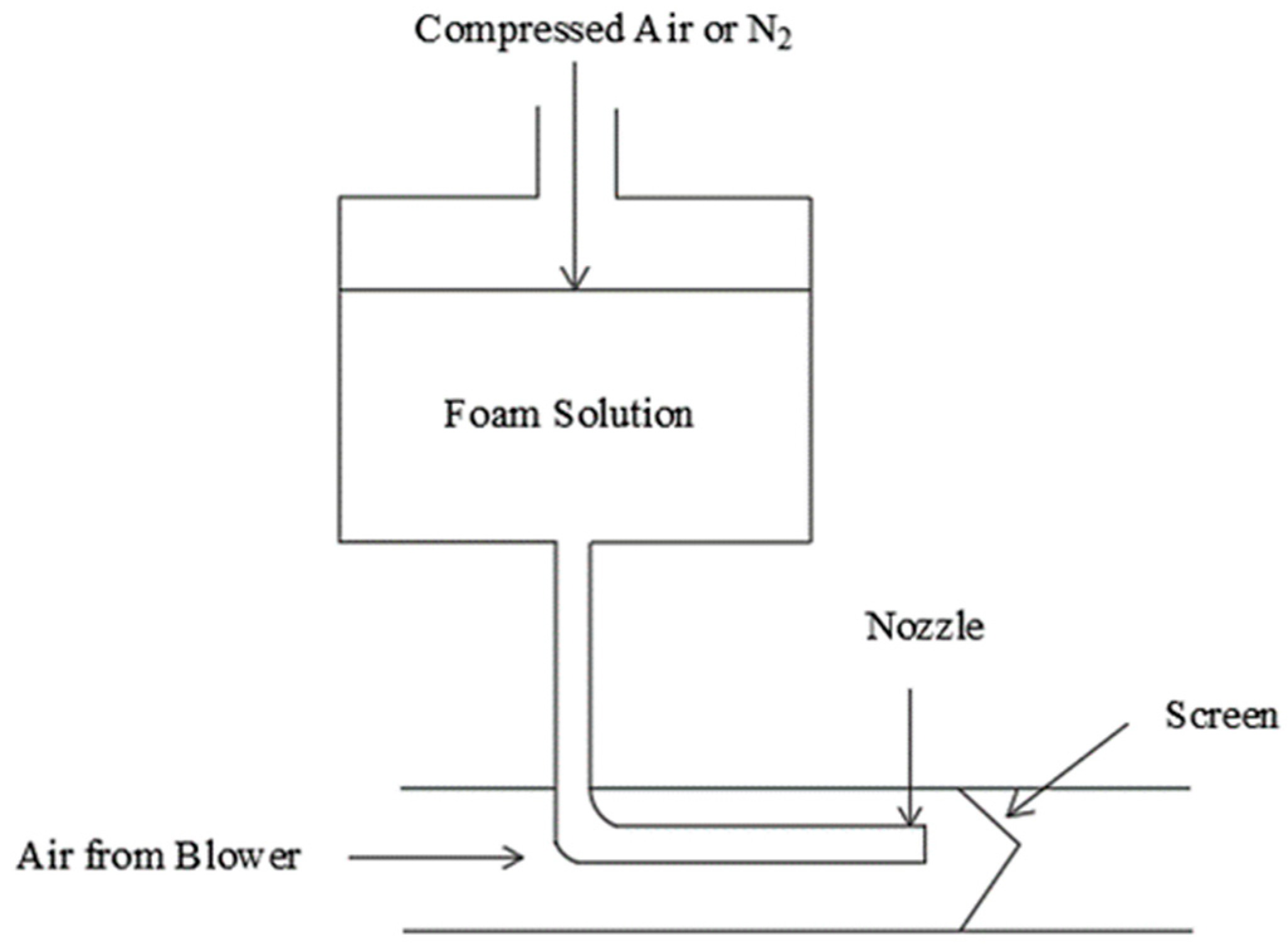
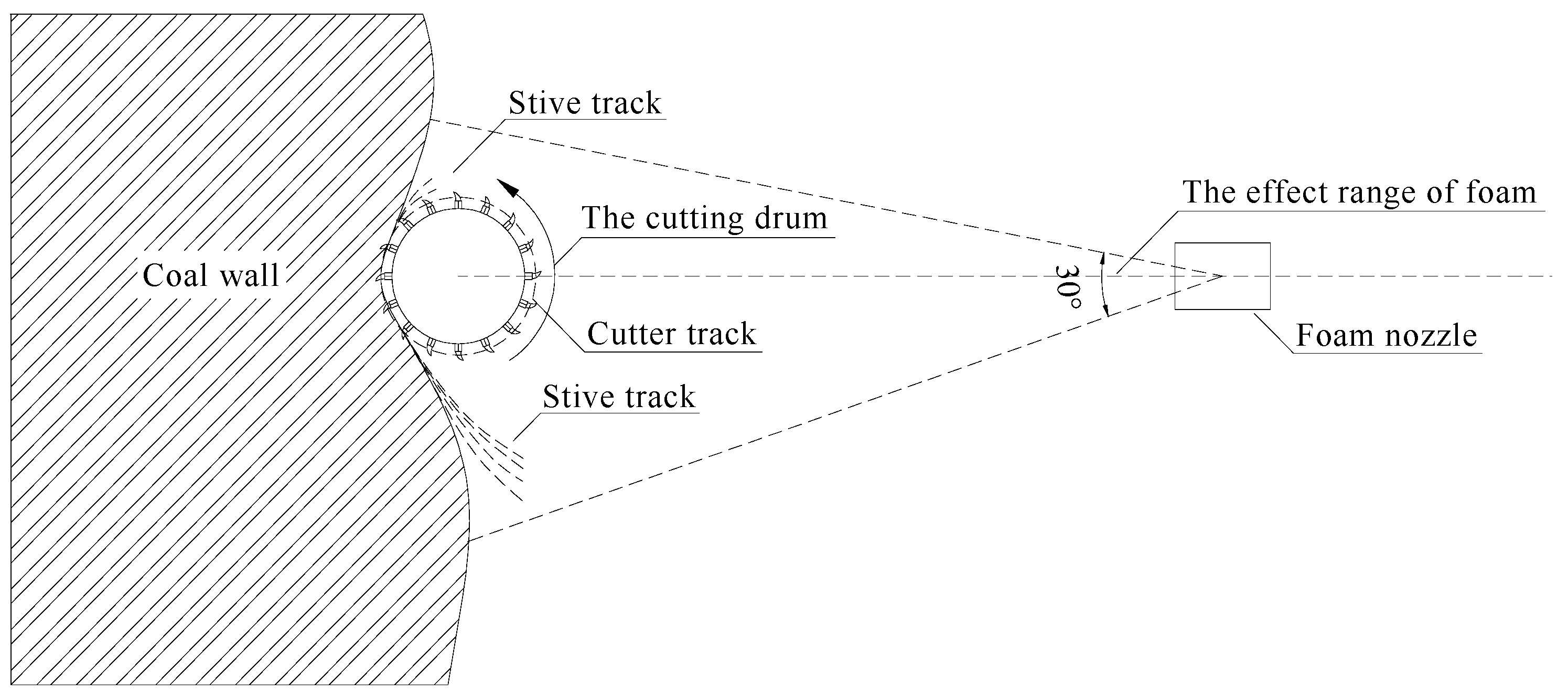
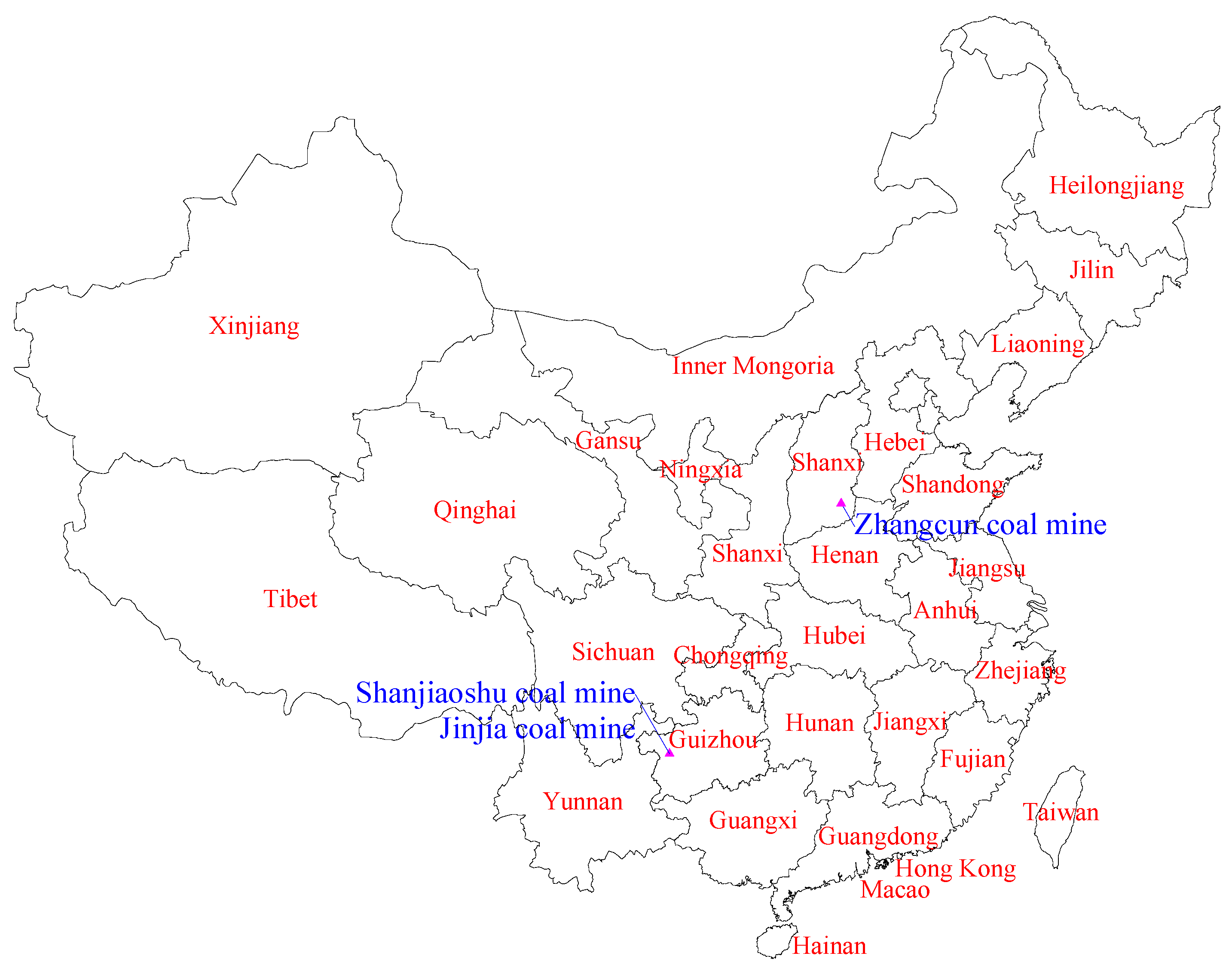
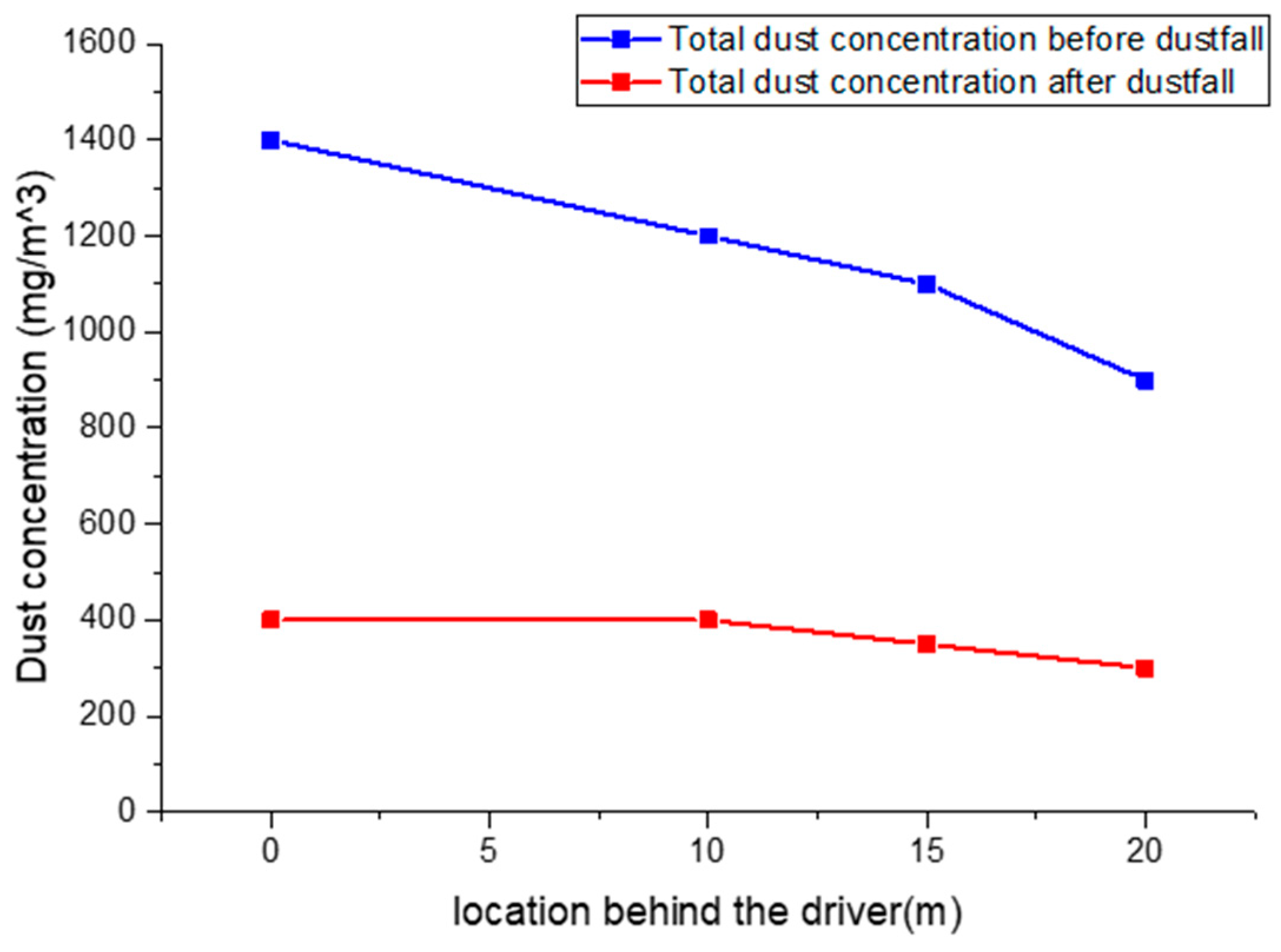
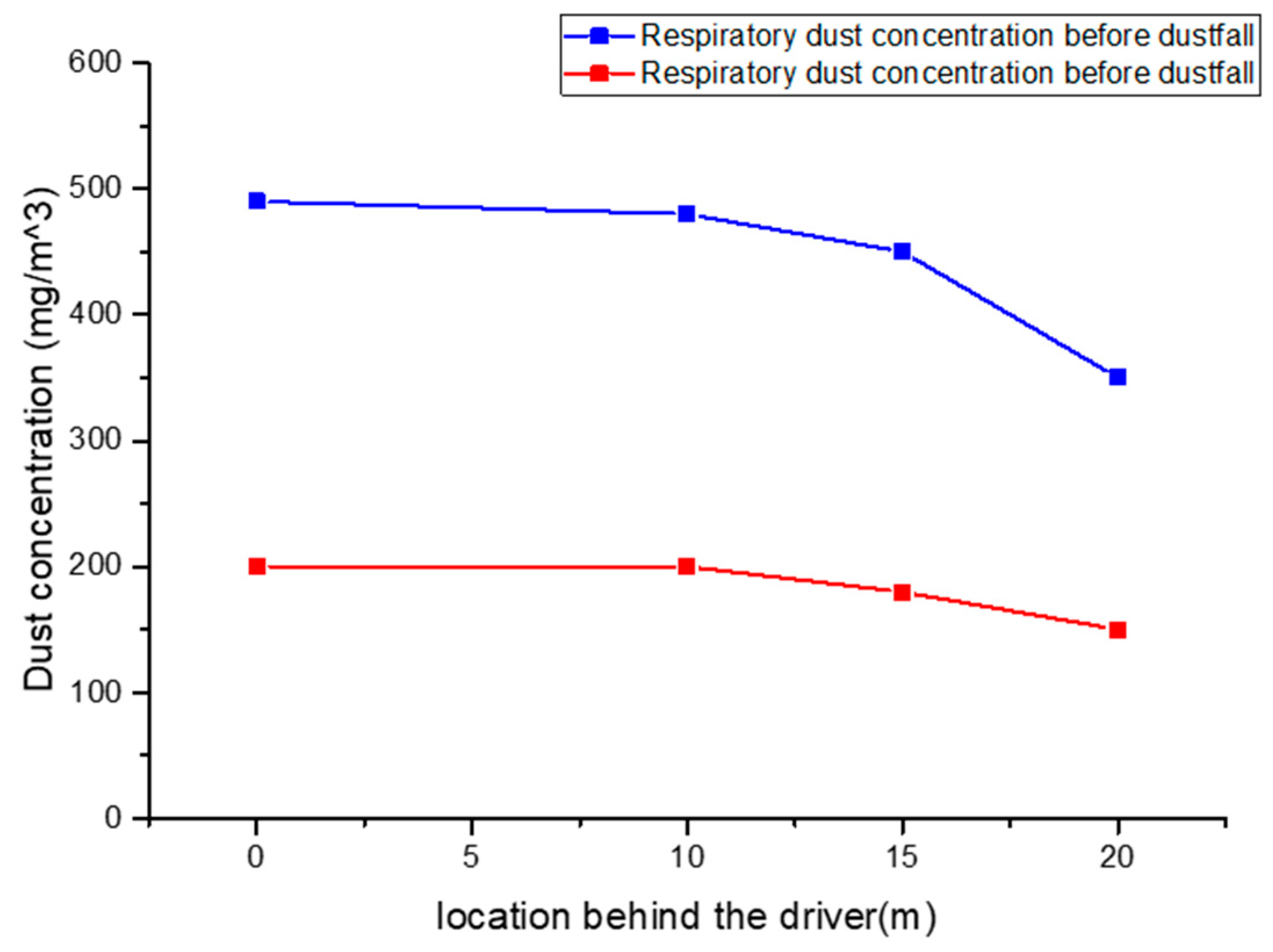
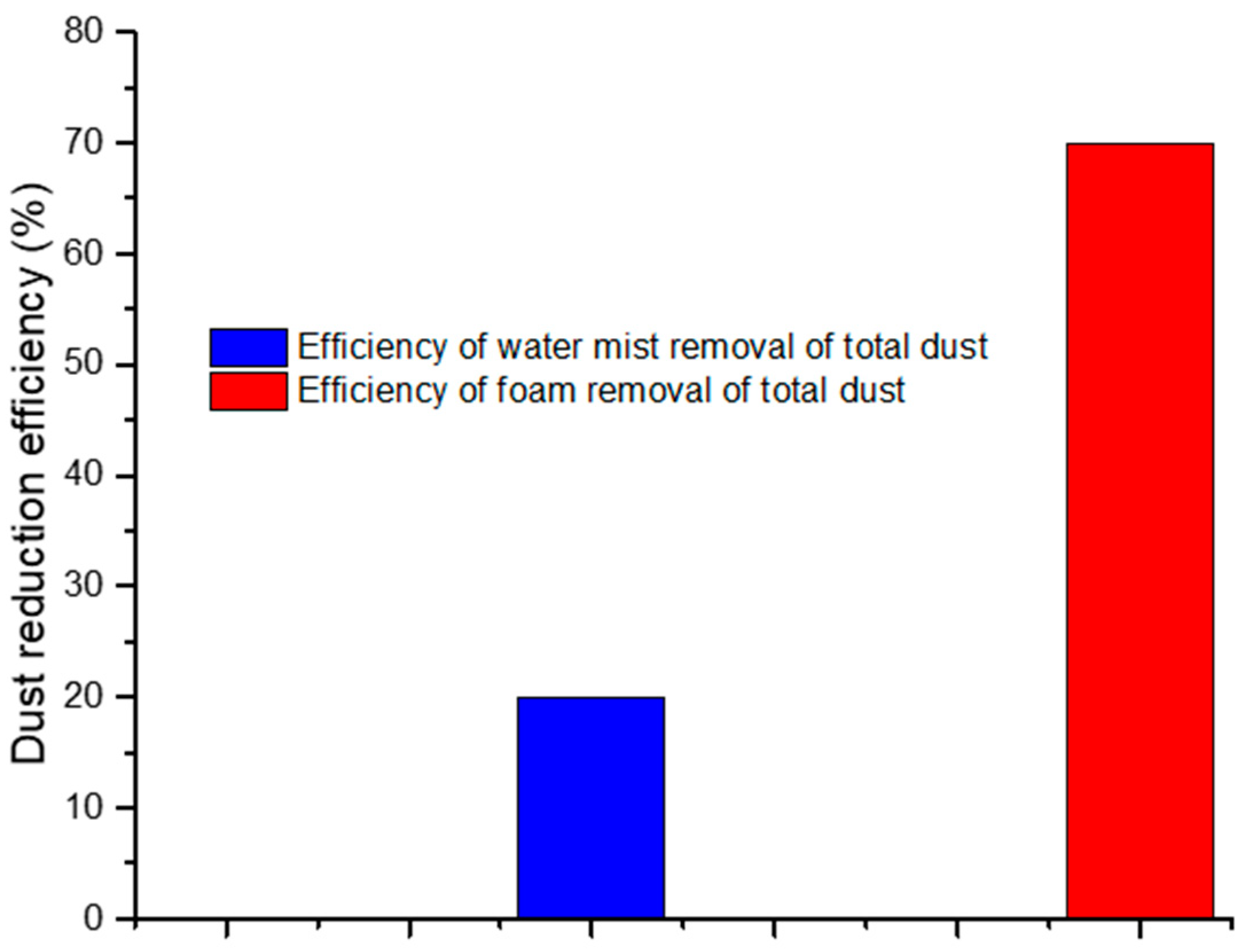
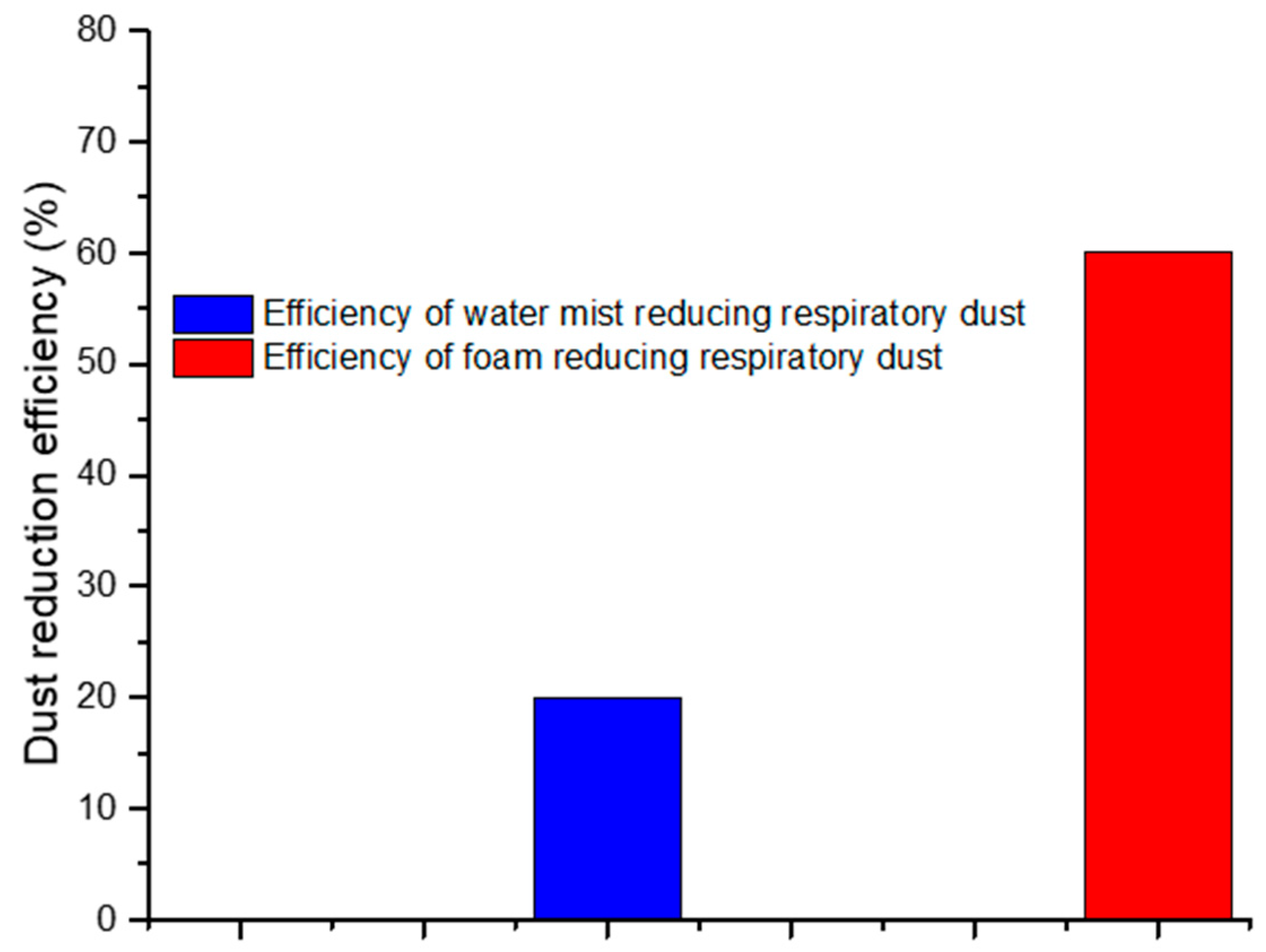

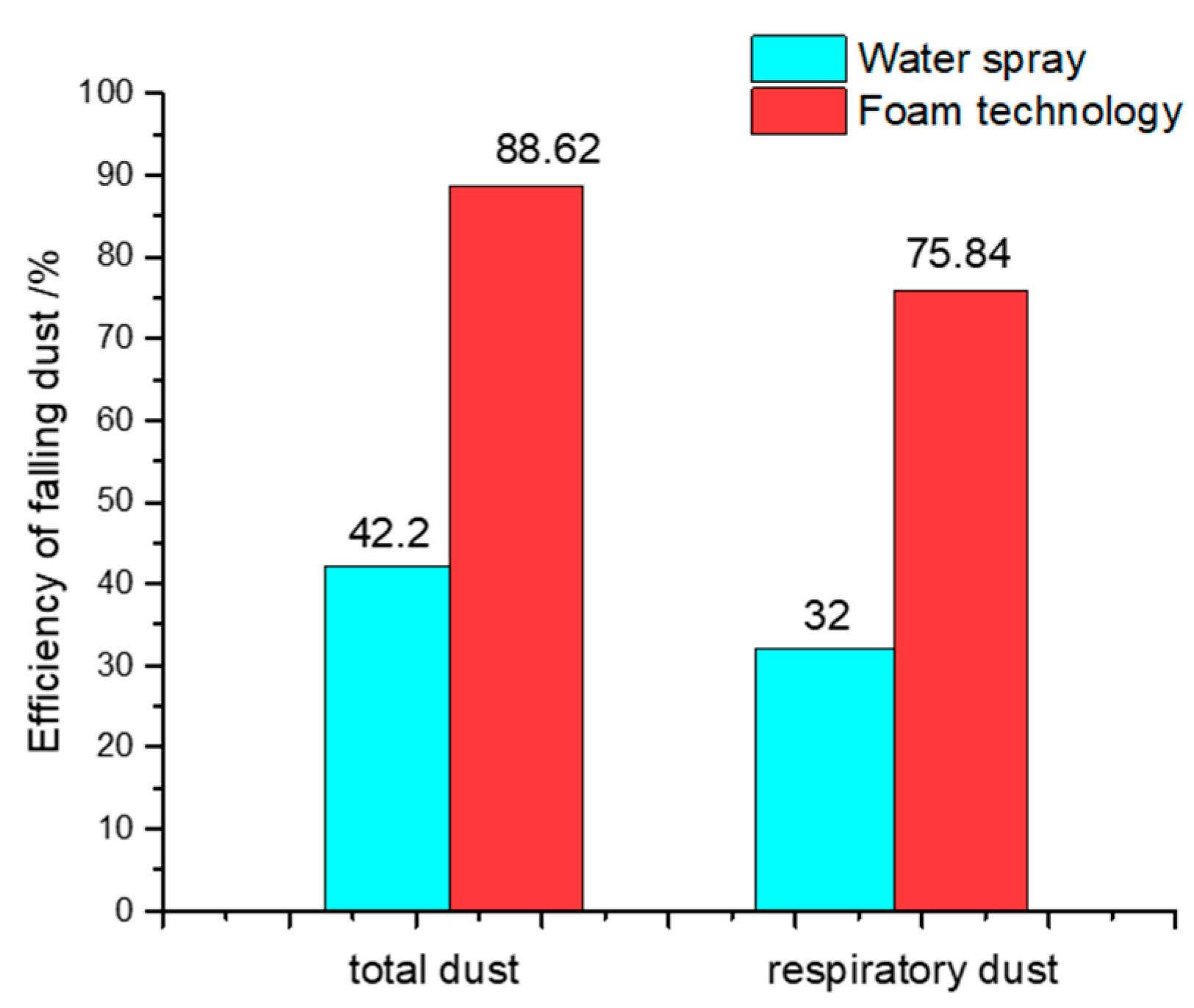


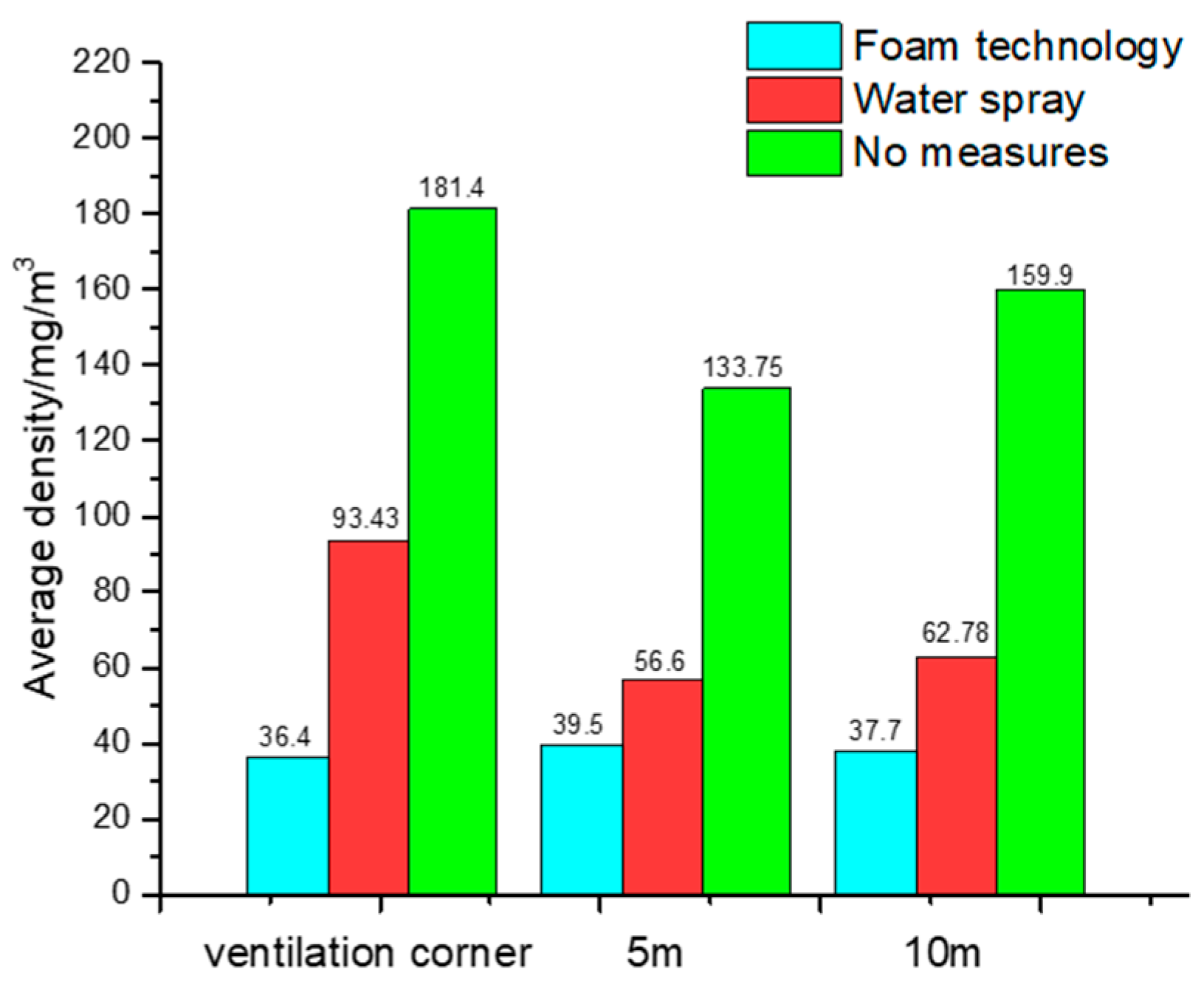

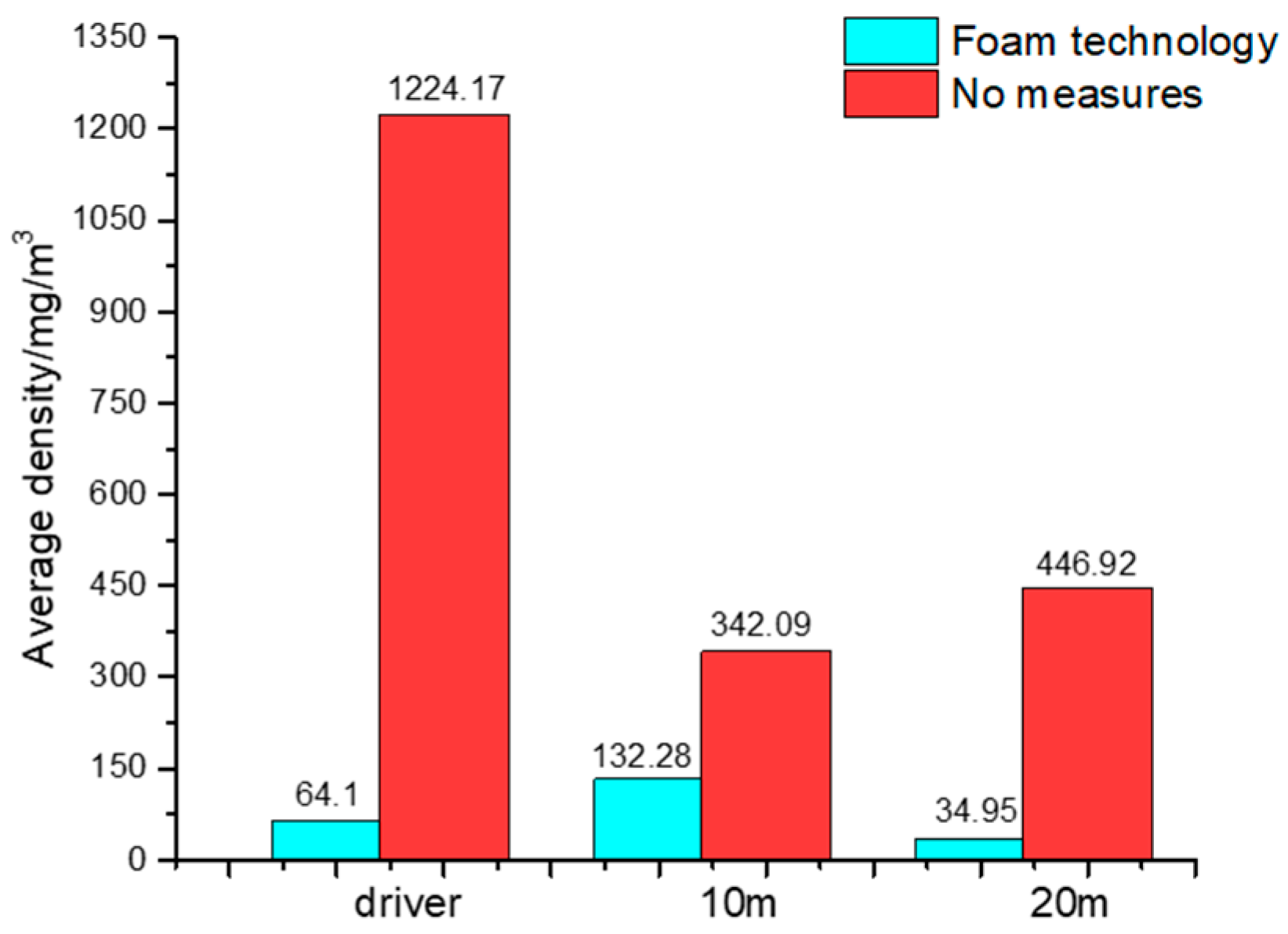
| Accident Time | Accident Coal Mine | Casualties | Type of Accident |
|---|---|---|---|
| 27 November 1996 | Dongcun Coal Mine in Guojiayao, Datong | 110 dead, 4 missing | gas and coal dust explosions |
| 27 September 2000 | Muchonggou Coal Mine in Shuicheng, Guizhou | 162 dead, 37 injured | gas and coal dust explosions |
| 22 July 2001 | Jiawanggangzi fifth auxiliary well in Xuzhou | 92 dead | coal dust explosion |
| 20 August 2001 | Xijiabu Coal Mine in Zaozhuang | 13 dead | coal dust explosion |
| 27 December 2001 | Wennan Coal Mine in Xinwen, Shandong | 22 dead, 24 injured | coal dust explosion |
| 13 May 2003 | Luling Coal Mine in Huaibei | 86 dead, 28 injured | gas and coal dust explosions |
| 21 October 2003 | Luotuoshan Mine in Wuhai, Inner Mongolia | 6 dead | coal dust explosion |
| 18 May 2004 | Caijiagou Coal Mine in Luliang, Shanxi | 33 dead | coal dust explosion |
| 14 February 2005 | unjiawan Coal Mine in Fuxin, Liaoning | 214 dead | gas and coal dust explosions |
| 27 November 2005 | Dongfeng Coal Mine in Qitaihe, Heilongjiang | 146 dead | gas and coal dust explosions |
| 29 October 2006 | A mine of Xinjiang Construction Corps | 14 dead | coal dust explosion |
| 16 April 2007 | Wangzhuang Coal Mine in Pingdingshan, Henan | 33 missing | coal dust explosion |
| 21 May 2008 | Wanlong Mine in Yangquan, Shanxi | 5 dead, 1 injured | coal dust explosion |
| 26 November 2014 | Fuxin Mine in Liaoning | 28 dead, 50 injured | coal dust explosion |
| Dust Removal Technology | Advantages | Disadvantages | Dust Removal (Suppression) Efficiency |
|---|---|---|---|
| coal seam water injection | pre-wet the coal body, the wetting range is large, and the coal body is evenly wetted | The equipment is complex, the water consumption is large, the engineering volume is large, the one-time investment is large, there are difficulties in the sealing process, water injection method and equipment, and the dust removal efficiency is low | 7%~50% |
| spray dust removal | simple equipment, low cost, small footprint, less maintenance, low maintenance cost, and low management workload | Most coal dust has a certain degree of hydrophobicity, the surface tension of water is large, many coal dust is not easy to be completely wetted and captured by water, and the dust removal efficiency is low, especially for respiratory dust. | Below 50% |
| chemical dust suppression | increase the wettability of dust and improve the dust removal efficiency of spray and coal seam water injection | The operating cost is high, the equipment is easily corroded and the operation is complicated. | Below 60% |
| Dust collector dust removal | high dust removal efficiency | large one-time investment, complex structure of the equipment itself, large volume, heavy weight and limited air volume | 70%~95% |
| Ventilation and dust removal | simple operation, convenient and fast, low cost | low dust removal efficiency and easy to cause secondary pollution | Below 60% |
| Place of Application | Foaming Agent Name | Use Concentration (%) | Dust Removal Efficiency (%) |
|---|---|---|---|
| Shearer in Karaganda Mine | High multiple foam no.-1 | 3–4 | 95.2 |
| Karaganda Mine Transfer Point | High multiple foam no.-1 | 3–4 | 94 |
| Donbas mine shearer | Medium multiple foam no.-1 | 2–3 | Above 88 |
| Rostov Coal Mine Shearer | Low multiple foam no.-1 | 1 | 69 |
| Kirov Mine | Cyclic imine | 0.0005–0.005 | 60% lower than 0.1% no.-1 |
| Working Face Total Dust Concentration mg/m3 | Total Respirable Mineral Dust Concentration of Working Face mg/m3 | Mineral Dust Concentration in Suspended Air after Water Mist Dusting mg/m3 | Concentration of Respirable Mineral Dust in Suspended Air after Dust Fall by Water Mist mg/m3 | Mineral Dust Concentration in Suspended Air after Foam Dusting mg/m3 | Respirable Mineral Dust in Suspended Air after Foam Dust Reduction mg/m3 | |
|---|---|---|---|---|---|---|
| measurement data | 1629 (10.20) * | 622.5 (10.20) | 1297.5 (10.20) | 413.5 (10.20) | 443.5 (11.08) | 199 (11.08) |
| 1197 (10.23) | 353 (10.23) | 952.1 (10.23) | 347.5 (10.23) | 373.5 (11.10) | 196 (11.10) | |
| average | 1413 | 487.8 | 1124.8 | 380.5 | 408.5 | 197.5 |
| dust reduction efficiency (%) | 20.4 | 22.0 | 71.1 | 59.5 | ||
| Measure Time | Working Face Total Dust Concentration mg/m3 | Total Respirable Mineral Dust Concentration of Working Face mg/m3 | Mineral Dust Concentration in Suspended Air after Foam Dusting mg/m3 | Respirable Mineral Dust in Suspended Air after Foam Dust Reduction mg/m3 | ||
|---|---|---|---|---|---|---|
| the return air side 10 m behind the roadheader driver (that is, at the loader) | measurement data | 12 November | 1319 | 543.5 | 356.5 | 179 |
| 15 November | 1035.5 | 417.5 | 457 | 221 | ||
| average | 1177.3 | 480.5 | 406.8 | 200 | ||
| dust reduction efficiency (%) | 65.4 | 58.4 | ||||
| 5 m behind the loader | measurement data | 17 November | 959 | 347.5 | 323 | 163 |
| 20 November | 1231 | 540 | 399.5 | 193 | ||
| average | 1095 | 443.8 | 361.3 | 180 | ||
| dust reduction efficiency (%) | 67.0 | 59.4 | ||||
| 20 m behind the roadheader driver (i.e., 10 m behind the loader) | measurement data | 22 November | 737.5 | 340 | 298 | 140 |
| 23 November | 1060 | 400 | 317 | 150 | ||
| average | 898.8 | 360 | 297.5 | 145 | ||
| dust reduction efficiency (%) | 66.9 | 59.7 | ||||
| Density of Total Mine Dust mg/m3 | Density of Total Respiratory Mine Dust mg/m3 | Density of Mine Dust after Water Spraying mg/m3 | Density of Respiratory Mine Dust after Water Spraying mg/m3 | Density of Mine Dust after Foam mg/m3 | Density of Respiratorymine Dust after Foam mg/m3 | |
|---|---|---|---|---|---|---|
| Test data | 287.67 | 133.17 | 120.33 | 41.81 | 101.5 | 32.3 |
| 389.33 | 106.49 | 218.67 | 91.16 | 96.3 | 35.38 | |
| 331.26 | 90.26 | 157.25 | 33.5 | 88.66 | 30.25 | |
| 346.09 | 87.64 | 325.33 | 62.17 | 98.33 | 33.17 | |
| 324.61 | 57.1 | 212.47 | 72.14 | 76.33 | 22.37 | |
| 356.31 | 96.68 | 198.36 | 42.31 | 106.83 | 35.17 | |
| Average | 339.21 | 95.22 | 205.40 | 57.18 | 94.65 | 31.44 |
| Efficiency of dust control (%) | 39.45 | 39.95 | 72 | 67 | ||
| Water demand (10 m3/h) | 10 | 15 | ||||
Publisher’s Note: MDPI stays neutral with regard to jurisdictional claims in published maps and institutional affiliations. |
© 2022 by the authors. Licensee MDPI, Basel, Switzerland. This article is an open access article distributed under the terms and conditions of the Creative Commons Attribution (CC BY) license (https://creativecommons.org/licenses/by/4.0/).
Share and Cite
Ji, M.; Sun, Z.; Guo, H. The Application of the Foam Technology to the Dust Control for Reducing the Dust Injury of Coal Mines. Appl. Sci. 2022, 12, 10878. https://doi.org/10.3390/app122110878
Ji M, Sun Z, Guo H. The Application of the Foam Technology to the Dust Control for Reducing the Dust Injury of Coal Mines. Applied Sciences. 2022; 12(21):10878. https://doi.org/10.3390/app122110878
Chicago/Turabian StyleJi, Ming, Zhongguang Sun, and Hongjun Guo. 2022. "The Application of the Foam Technology to the Dust Control for Reducing the Dust Injury of Coal Mines" Applied Sciences 12, no. 21: 10878. https://doi.org/10.3390/app122110878





